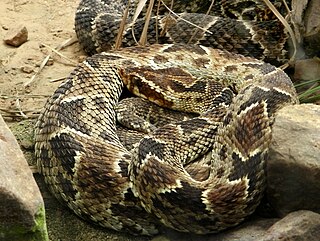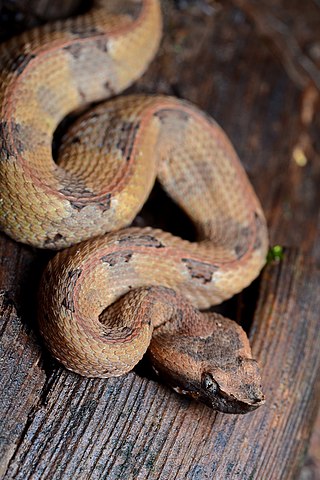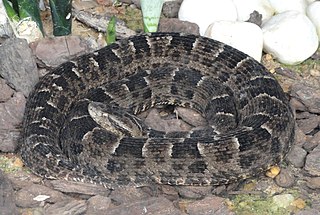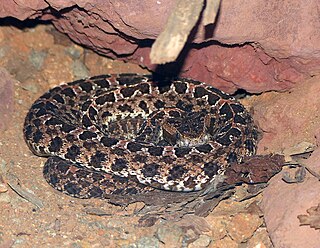
Metlapilcoatlus is a genus of venomous pit vipers endemic to Mexico and Central America. Six species are currently recognized. The common names suggest they are able to leap at an attacker, but this is likely exaggerated. Common names for the species include jumping pitvipers and jumping vipers. The genus name comes from the Nahuatl name metlapilcohuatl, which means of the oblong grindstone held in the hand when grinding corn - alluding to the snakes short stocky body.

Bothrops barnetti, also known commonly as Barnett's lancehead and Barnett's pit viper, is a species of venomous snake, a pit viper in the subfamily Crotalinae of the family Viperidae. The species is endemic to Peru. There are no subspecies that are recognized as being valid.

Bothriechis marchi, also known as Honduran palm pit viper and March's palm pit viper, is a species of pitviper, a venomous snake, in the subfamily Crotalinae of the family Viperidae. The species is endemic to Central America. There are no subspecies that are recognized as being valid.

Cerrophidion tzotzilorum is a venomous pit viper species which is native to southern Mexico. There are no subspecies that are recognized as being valid.

Porthidium hespere is a venomous pitviper species found in western Mexico. No subspecies are currently recognized.

Porthidium nasutum is a venomous pitviper species found in southern Mexico, Central America and northern South America. No subspecies are currently recognized.

Bothrops taeniatus, the speckled forest-pitviper, is a species of pit viper found in the equatorial forests of South America endemic to Colombia, Ecuador, Peru, And Brazil. The specific name, taenia, is derived from the Greek word, tainia, meaning ribbon bandage or stripe, in reference to the slender body. Two subspecies are currently recognized, including the nominate subspecies described here.

Bothrops neuwiedi is a highly venomous pit viper species endemic to South America. This relatively small snake has a wide range and is a major source of snakebite in Argentina. It was named after German naturalist Prince Maximilian of Wied-Neuwied (1782-1867), who made important collections in Brazil (1815-1817). Seven subspecies are currently recognized, including the nominate subspecies described here.

Bothrops bilineatus, also known as the two-striped forest-pitviper, parrotsnake, Amazonian palm viper, or green jararaca, is a highly venomous pit viper species found in the Amazon region of South America. Two subspecies are currently recognized, including the nominate subspecies described here. A pale green arboreal species that may reach 1 m (3.3 ft) in length, it is an important cause of snakebite throughout the entire Amazon region.

Porthidium ophryomegas is a venomous pitviper species found in Central America. No subspecies are currently recognized.
Bothrops medusa is a venomous pitviper species endemic to Venezuela. No subspecies are currently recognized.

Bothrops oligolepis is a venomous pitviper species found in Peru and Bolivia. The specific name is derived from the Greek words oligo and lepis, meaning "few scales"; probably an allusion to the lower numbers of dorsal and ventral scales that it has compared to B. bilineatus. No subspecies are currently recognized.
Bothrops pulcher is a venomous pitviper species found in South America. The specific name is Latin, meaning "beautiful", in reference to the color pattern. No subspecies are currently recognized.

Bothrops punctatus is a venomous pitviper species found in Ecuador, Mostly in the Chocó Department in Western Colombia and Panama. No subspecies are currently recognized.
Bothrops taeniatus lichenosus is a venomous pitviper subspecies endemic to South America and known only from one locality in Bolívar State, Venezuela.

Bothrops brazili is a venomous pitviper species endemic to South America. There are no subspecies that are recognized as being valid.
Bothrocophias campbelli, commonly known as Campbell's toadheaded viper, the Ecuadorian toadheaded pitviper, and víbora boca de sapo in Spanish, is a species of venomous pitviper in the family Viperidae. The species is endemic to South America. No subspecies are currently recognized.
Bothrocophias colombianus, commonly known as the Colombian toad-headed pitviper, is a species of venomous snake in the family Viperidae. It is endemic to South America.

Bothrops jonathani, known commonly as Jonathan's lancehead or the Cochabamba lancehead, is a species of venomous snake, a pit viper in the family Viperidae. The species is endemic to South America.

Bothrocophias lojanus, also known commonly as the Lojan lancehead in English, and macanchi or macaucho in Spanish, is a species of venomous pit viper in the subfamily Crotalinae of the family Viperidae. The species is native to northwestern South America.















